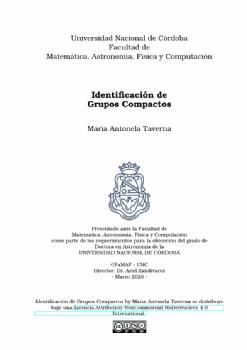| dc.contributor.advisor | Zandivarez, Arnaldo Ariel | |
| dc.contributor.author | Taverna, Maria Antonela | |
| dc.date.accessioned | 2021-05-11T17:42:10Z | |
| dc.date.available | 2021-05-11T17:42:10Z | |
| dc.date.issued | 2020 | |
| dc.identifier.uri | http://hdl.handle.net/11086/18198 | |
| dc.description | Tesis (Doctor en Astronomía)--Universidad Nacional de Córdoba, Facultad de Matemática, Astronomía, Física y Computación, 2020. | es |
| dc.description.abstract | En esta tesis doctoral se han adoptado como objeto de estudio los grupos compactos (CGs) de galaxias. Estos sistemas contienen unas pocas galaxias en una región muy pequeña y se consideran localmente aislados. A lo largo de esta tesis realizamos estudios estadísticos sobre CGs identificados principalmente en simulaciones numéricas y en catálogos observacionales. Estudiamos la influencia de la banda fotométrica en la identificación de estos sistemas usando un mismo identificador. Posteriormente mejoramos el algoritmo de identificación de CGs usando el criterio tipo Hickson. Además, estudiamos cómo la naturaleza y frecuencia de estos grupos dependen de la cosmología. Por último realizamos un estudio de la pureza y la completitud de muestras en el espacio de redshifts. El objetivo de este trabajo fue tratar de aportar nueva información sobre temáticas relacionadas con la identificación de los CGs. | es |
| dc.description.abstract | In this doctoral thesis, we studied the compact groups of galaxies (CGs). These groups are isolated systems that contain a few galaxies in an area very small. We realised statistical studies about compact groups of galaxies which were identified in numerical simulations as well as in observational catalogues. We study the impact of the photometric band used in the identification of CGs using a unique algorithm. Subsequently, we improve the algorithm of identification of CGs using the Hickson criteria but with an optimisation to apply it in redshifts space. Besides, we realised a comparative study to understand how the frequency and three-dimensional nature of CGs depend on cosmological parameters. Finally, we analyse the purity and completeness of the catalogues of CGs identified in redshifts space. The objective of this work was to try to contribute new information on issues related to the identification of CGs. | en |
| dc.language.iso | spa | es |
| dc.rights | Attribution-NonCommercial-NoDerivatives 4.0 Internacional | * |
| dc.rights.uri | http://creativecommons.org/licenses/by-nc-nd/4.0/ | * |
| dc.subject | Catálogos de galaxias | es |
| dc.subject | Simulaciones cosmológicas | es |
| dc.subject | Grupos compactos de galaxias | es |
| dc.subject | Dark matter | en |
| dc.subject | Statistical and correlative studies of properties | en |
| dc.subject | Galaxy groups, clusters, and superclusters; large scale structure of the Universe | en |
| dc.subject | Observation and data reduction techniques; computer modeling and simulation | en |
| dc.subject | Small and compact galaxy groups | en |
| dc.title | Identificación de grupos compactos | es |
| dc.type | doctoralThesis | es |
| dc.description.version | publishedVersion | |
| dc.description.fil | Fil: Taverna, María Antonela. Universidad Nacional de Córdoba. Facultad de Matemática, Astronomía, Física y Computación; Argentina. | es |





